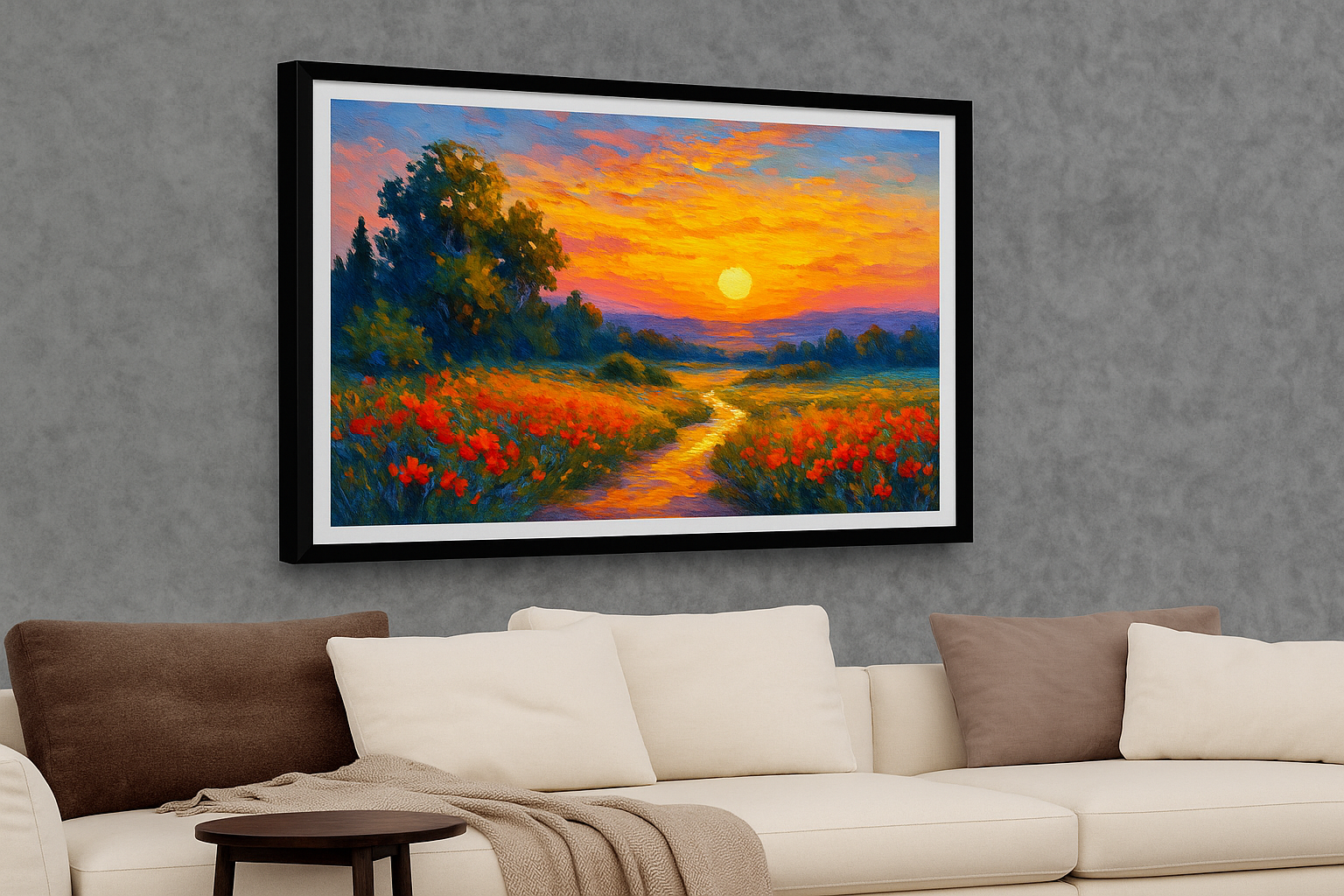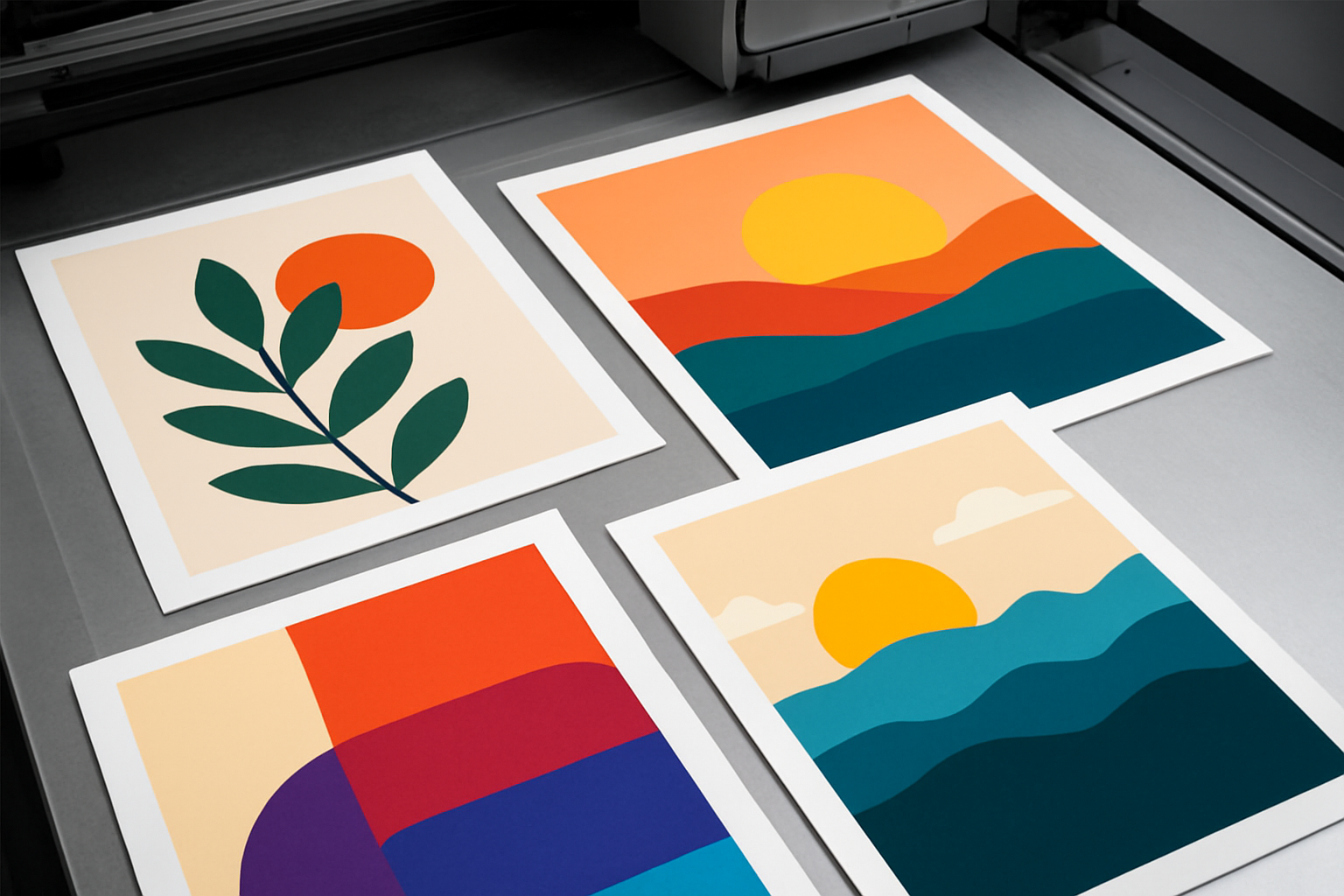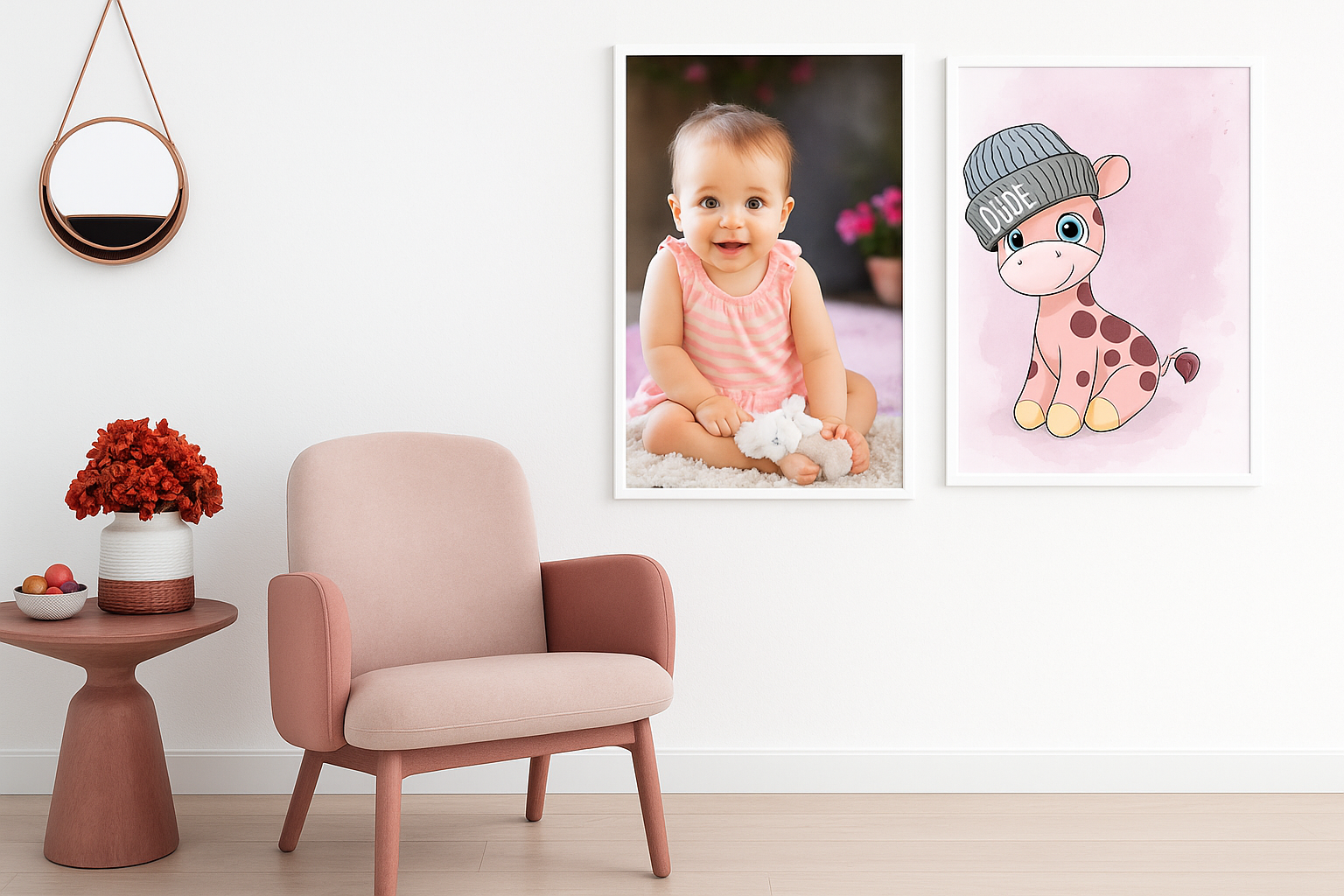Things You Should Know About Floating Frames

The right frame can completely change how a canvas prints looks on your wall. Among the many styles people choose today, floating frames stand out for their clean edges and elegant depth. The small gap between the canvas and the frame creates an illusion that the artwork is gently suspended inside, giving it a refined, gallery-style appearance.
Many people want to know what makes a floating frame special and how it compares to standard framing. Others are curious if it adds extra protection or simply improves the overall look. This blog will walk you through everything you need to know before selecting a floating frame for your next canvas print.
At CanvasChamp, every print is created to showcase your memories beautifully. From family portraits to scenic photos, a floating frame can add that final touch of sophistication that makes your artwork truly stand out.
What Is a Floating Frame for Canvas Prints?
A floating frame is a stylish outer frame that gives your canvas print the appearance of floating inside its border. Instead of pressing against the edges of the artwork like a traditional frame, it leaves a narrow gap between the frame and the canvas. This spacing creates a soft shadow around the edges, adding depth and dimension that make the artwork look more prominent on the wall.
Floating frames are often used to enhance canvas prints, photography, and paintings because they add a modern finish without hiding any part of the image. The design draws attention to the artwork itself rather than the frame, making it perfect for homes, studios, and gallery walls.
In contrast to framed prints, where the edges are hidden under a mat or inner border, a floating frame leaves the entire image visible. It’s a minimal yet elegant way to highlight the edges of the print while protecting it from accidental bumps or scratches.
Floating frames come in a variety of colors and materials such as natural wood, black, or white finishes. Each option complements a different type of décor—warm tones for rustic spaces, sleek black for contemporary rooms, and lighter wood for casual or coastal interiors.
How Does a Floating Frame Work?
A floating frame holds the canvas from the back or sides instead of covering its edges. The canvas is mounted inside the frame with a small space around it, creating the illusion that it’s floating. This design lets light form a soft shadow between the print and the frame, which gives the artwork a sense of depth and dimension.
When you order framed canvas prints, the process begins with stretching your canvas tightly over a sturdy wooden base. The floating frame is then attached around the canvas with careful alignment, leaving a gap of a few millimeters to keep the edges visible. The result is a sleek, professional finish that highlights every detail of your photo.
Unlike regular frames that press the artwork flat, floating frames protect the edges from wear and bending. The hidden support behind the canvas also makes the frame stronger and easier to hang on the wall.
This framing method is often chosen for modern home décor and gallery setups because it enhances both small and large prints without adding bulk. It’s especially effective for panoramic or statement pieces where edge visibility adds extra visual impact.
Floating Frame vs Regular Frame: What’s the Difference?
Understanding the difference between floating frames and regular frames helps you decide which style best fits your photo or artwork. Both serve the same purpose—protecting and displaying your print—but they create very different visual effects.
Floating Frame
A floating frame surrounds the canvas without touching its edges. It leaves a narrow space between the frame and the artwork, creating a subtle shadow that makes the print look like it’s suspended inside. This adds depth, enhances the texture of the canvas, and gives a clean, modern appearance. Floating canvas frames are ideal for canvas prints, digital art, and photography that deserve a gallery-like presentation.
Regular Frame
A regular frame covers the edges of the artwork completely. It often includes a mat or border that overlaps the image. This traditional framing style provides extra protection and works well for paper prints, posters, and photographs that need added support. It gives a classic, polished look but hides the edges of the artwork.
Key Differences
|
Feature |
Floating Frame |
Regular Frame |
|
Edge Visibility |
Full edges visible |
Edges covered |
|
Look & Style |
Modern, gallery-inspired |
Classic, traditional |
|
Depth Effect |
Creates a shadow gap |
Flat, enclosed finish |
|
Protection Level |
Moderate, protects edges |
Strong, encloses artwork |
|
Best For |
Canvas Prints and gallery pieces |
Photos, posters, and fine art papers |
|
Typical Use |
Home décor, office walls, exhibitions |
Portraits, certificates, classic art |
Which Is Better?
Both frame types look beautiful, but the choice depends on the style you want. If you love a minimalist, modern finish that keeps your photo visible from edge to edge, go for a floating frame. If you prefer a more formal, enclosed look, a framed canvas wall display or traditional frame might be the better option.
Pros and Cons of Floating Frames
Floating frames are one of the most popular choices for displaying canvas prints because they combine modern design with simple elegance. Still, like any framing option, they come with both benefits and trade-offs. Here’s a closer look at the main pros and cons.
Advantages of Floating Frames for Canvas Prints
1. Modern and stylish appearance
A floating frame gives your canvas a professional, gallery-inspired look. The visible space between the canvas and frame adds dimension and makes the artwork appear more refined. It’s perfect for canvas prints, art photography, and minimal interiors.
2. Protects canvas edges
The frame acts as a barrier, preventing scratches, dents, or frayed corners. The canvas doesn’t touch the frame directly, which helps preserve its surface for years.
3. Highlights every detail
Unlike traditional frames that hide parts of the image, floating frames keep the full artwork visible. This makes them ideal for photos and paintings where edge details matter.
4. Versatile for any décor
Available in multiple finishes—black, white, walnut, and natural wood—floating frames suit both modern and rustic settings. The design works beautifully in living rooms, offices, studios, or galleries.
5. Lightweight and easy to hang
Even with the added frame, floating frames remain light. This makes them simple to mount using hooks or wall nails, which is convenient for quick home makeovers.
Disadvantages of Floating Frames
1. Slightly higher cost
Floating frames add to the overall price compared to unframed canvas prints. However, the upgrade often feels worthwhile for the premium finish and long-term durability.
2. Not ideal for very small prints
Smaller canvas prints might lose their visual balance because the frame gap takes up a noticeable portion of the design. These work best on medium or large prints.
3. Limited design variety
While floating frames look elegant, they follow a minimal style. If you prefer decorative moldings or ornate patterns, a traditional framed canvas print might fit better.
Are Floating Frames Worth It?
For most people, yes. A floating frame enhances the look of any photo canvas by adding depth and giving it a professional edge. It’s a small investment that delivers a big upgrade in appearance and presentation quality.
If you love displaying travel memories, family portraits, or pet photos, pairing them with a floating frame can make your photo prints look truly special.
Common Materials Used for Floating Frames
1. Wood Floating Frames
Wood frames bring warmth and texture to any photo or painting. They work beautifully for framed canvas prints that feature family portraits, nature shots, or artwork with soft color tones. Popular choices include oak, walnut, pine, and maple.
Each type of wood offers a distinct grain and natural shade that adds character to your space.
2. Metal Floating Frames
Metal frames are known for their clean lines and minimal look. They pair well with modern interiors and metal prints. Aluminum and steel frames in matte black or brushed silver finishes are often used to achieve a sleek, contemporary vibe. These are lightweight yet durable, making them ideal for larger canvases.
Best Floating Frame Colors for Canvas Prints
The frame color should complement your photo and your wall color. Here are a few timeless combinations that always look balanced:
- Black frames – Perfect for dramatic photos and modern décor.
- White frames – Great for bright spaces and colorful artwork.
- Natural wood tones – Best for rustic, coastal, or organic styles.
- Walnut and dark brown – Adds warmth to family portraits or classic art pieces.

If your photo features multiple tones or textures, choose a neutral frame that lets the artwork remain the focal point.
Floating Frame Finishes and Design Ideas
Floating frames are available in smooth matte, glossy, or textured finishes. A matte frame gives a calm and understated look, while a glossy finish adds a polished edge that works well for photo prints and vivid travel images.
For a softer feel, natural wood or brushed metal frames can create a balance between elegance and warmth.
Mixing frame finishes is another creative approach. For example, pairing black frames with natural wood pieces across a gallery wall adds visual variety without looking cluttered.
How to Choose the Right Floating Frame for Your Canvas
Selecting the right floating frame is about more than style—it’s about finding the perfect balance between your artwork, your wall color, and the mood of your space. The right combination can make your canvas look intentional and professionally designed.
1. Match the Frame to the Artwork
Every photo or artwork carries its own color palette and emotion. Choose a frame that enhances those tones instead of competing with them.
- Black frames add contrast and work beautifully with bold, high-contrast images.
- White frames keep things bright and airy, perfect for pastel or minimal artwork.
- Wood frames bring warmth and a natural feel to nature shots or vintage photos.
If you’re displaying a collection of canvas prints or canvas collage on the same wall, keeping the frame color consistent helps create a cohesive gallery look.
2. Consider Your Wall Color and Room Style
Your wall color plays a big role in how your framed canvas appears. Light walls pair well with darker frames that define the artwork. Dark walls look best with white or natural-toned frames that create contrast.
For modern homes, matte black or metallic floating frames look sleek. Rustic or coastal spaces benefit from lighter wood tones and visible grain textures.
3. Think About Size and Proportion
Larger canvases often look best with thicker floating frames that add structure without overpowering the print. Smaller canvases, on the other hand, need slimmer frames to maintain balance.
If you’re unsure about proportions, you can preview options while customizing your small-sized tabletop canvas prints on CanvasChamp before placing your order.
4. Reflect the Mood of the Image
Every frame adds its own personality. A glossy metal frame feels sleek and contemporary, while a natural wooden frame gives off a warm and homely charm. Match the tone of your frame with the story your photo tells—formal portraits deserve polished finishes, while travel memories feel more relaxed in rustic tones.
5. Keep Lighting in Mind
Good lighting enhances the floating effect. Natural or directional light will make the shadow gap more visible, emphasizing the “floating” illusion.
For artwork displayed near windows or under spotlights, choose a matte finish to reduce glare and reflections.
Which Material Is Best for You?
If you prefer a modern, minimalist design, metal frames will suit your space best. If your goal is to create a cozy and timeless atmosphere, wood frames are the better choice. Both materials protect the canvas while enhancing its presentation, so the final decision depends on your personal taste and the look you want to achieve.
How Much Does a Floating Frame Cost?
The cost of a floating frame depends on the canvas size, frame material, and finish. On average, adding a floating frame increases the total price by 20–30% compared to an unframed canvas print.
Smaller prints (like 8x10 or 12x16 inches) are usually the most affordable, while large or panoramic pieces cost more due to added material and support.
Wood frames, such as walnut or oak, tend to be slightly pricier than metal frames, but they offer a warmer and more natural finish.
A framed canvas print is a worthwhile choice if you want a professional display that lasts for years. The elegant floating effect gives your artwork a premium look without a big jump in price.
How to Add a Floating Frame to Your Canvas Print on CanvasChamp
Adding a floating frame to your canvas print is quick and easy. Follow these simple steps to design your framed wall art:
- Select your canvas size – Choose the size that fits your wall space.
- Upload your photo – Add your image from your computer, phone, or social media.
- Add your frame – Pick one of the three available frame options: black, white, or walnut.
- Preview your artwork – See how your framed canvas will look before placing the order.
Every framed canvas print is made to order, ensuring a perfect fit, precise alignment, and premium quality. You can also explore photo prints for creating wall sets that blend different photo styles.
DIY Floating Frame vs Ordering Pre-Framed Canvas
Many people wonder if they can make a floating frame at home instead of ordering one. The answer is yes, but it depends on how much time, effort, and precision you want to invest.
DIY Floating Frame
Making your own frame involves measuring, cutting, and assembling wooden strips around the canvas with an even gap on all sides. It can be rewarding for those who enjoy craft projects but requires tools, space, and accuracy to get a neat finish.
Pre-Framed Canvas from CanvasChamp
Ordering a framed canvas print is the easier option. Each piece is professionally fitted, aligned, and ready to hang right out of the box. The frame is built to protect the canvas while keeping that clean floating effect.
Buying pre-framed also saves time and eliminates the need for tools or guesswork, giving you a perfect gallery-style finish every time.
How to Hang a Floating Frame Canvas
Hanging a floating frame canvas is simple and takes just a few minutes. Most pieces arrive ready to hang with hardware already attached.
Here’s how to do it:
- Mark the wall spot using a pencil.
- Use nails or picture hooks rated for your canvas weight.
- Hang the frame using the attached brackets or wire.
- Adjust it until it’s straight and centered.
For larger pieces, use wall anchors for extra stability. You can also follow our quick guide on how to hang canvas wall art for additional tips.
Floating Frame Maintenance and Cleaning Tips
Keeping your floating frame canvas looking new is easy with a few simple steps. Regular care helps preserve both the frame and the print for years.
Quick care tips:
- Use a soft, dry microfiber cloth to remove dust.
- Avoid using water or cleaning sprays on the frame or canvas.
- Keep the artwork away from direct sunlight, heat, and moisture.
- If needed, gently wipe the frame edges—never press on the canvas surface.
For long-term care, try rotating your framed canvas prints every few months to prevent uneven fading.

Floating Frames for Large Canvas Prints
Floating frames are an excellent choice for large or panoramic canvas prints. They add structure and strength while keeping the artwork visually light and balanced.
For oversized prints, sturdy wooden or metal frames provide extra support and prevent the canvas from bending over time. The small gap between the frame and the print also helps reduce pressure on the edges, keeping the artwork in perfect shape.
Floating Frames for Different Art Types
Floating frames enhance many kinds of artwork, from printed photos to hand-painted pieces. The open-edge design works well with different textures and colors, giving each type of art a clean and modern presentation.
For photography:
A floating frame adds depth and sharpness to vibrant photo prints, making colors stand out without distraction.
For paintings:
Artists often use floating frames to highlight brush textures and visible edges. The gap around the canvas keeps the painting’s details intact.
For digital art or modern designs:
Metal or black wood frames provide a sleek finish that suits minimal or abstract compositions.
Floating Frame FAQs
Q1. What is a floating frame used for?
A floating frame is used to give a canvas print a modern, gallery-style look. It adds depth and protects the canvas edges while keeping the artwork fully visible.
Q2. Do floating frames touch the canvas?
No. A small space separates the canvas from the frame, creating the “floating” effect and preventing any contact with the artwork.
Q3. Can I remove a floating frame from a canvas print?
Yes, but it’s not recommended. Removing it may loosen the stretched canvas or affect its alignment.
Q4. Do floating frames protect the artwork?
Yes. They shield the sides of the canvas from damage and reduce the risk of dents or scratches.
Q5. What is the gap between the floating frame and the canvas?
The gap is usually between 3 to 5 millimeters, wide enough to create a soft shadow and emphasize depth.
Q6. Can I use a floating frame for an existing wall art piece?
Yes, if the artwork is stretched on a wooden frame. Otherwise, it may need professional mounting.
Q7. Are floating frames suitable for paintings and prints?
Absolutely. They work well for photo prints, paintings, and digital art alike.
Q8. Do floating frames come in different colors and materials?
Yes. You can choose from black, white, walnut, or natural wood in both wood and metal finishes.
Q9. Is it easy to hang a floating frame canvas?
Yes. Most framed canvases come with hanging hardware pre-installed, making wall mounting simple and secure.
Q10. Are floating frames worth buying?
Yes. They enhance the look of any framed canvas print and offer long-lasting protection with minimal maintenance.
Is a Floating Frame Worth It?
A floating frame is a simple upgrade that makes a big difference. It gives your canvas prints a professional finish, adds depth, and protects the edges from everyday wear. The small added cost is well worth the lasting quality and elegant presentation it brings to your artwork.
If you want your favorite photos or art pieces to look gallery-ready, explore floater canvas prints at CanvasChamp. Choose your size, upload your image, and see how a floating frame can transform your walls into a personal art gallery.








